Caucasian War
| The Caucasian War | |||||||||
|---|---|---|---|---|---|---|---|---|---|
| Part of Russian conquest of the Caucasus | |||||||||
 Franz Roubaud's A Scene from the Caucasian War | |||||||||
| |||||||||
| Belligerents | |||||||||
|
|
| ||||||||
| Commanders and leaders | |||||||||
|
Emperor Nicholas I Emperor Alexander I Emperor Alexander II Aleksey Yermolov Mikhail Vorontsov Aleksandr Baryatinskiy Ivan Paskevich Nikolai Yevdokimov |
Mansur Ushurma Beibulat Taimin Shamil Gimry Gamzat-bek Ghazi Mullah Kazbech Tuguzhoko Akhmat Aublaa Shabat Marshan Haji Kerantukh Berzek | ||||||||
| Strength | |||||||||
| about 250,000 | unknown | ||||||||
| Casualties and losses | |||||||||
| roughly 96,000 | unknown | ||||||||
The Caucasian War (Russian: Кавказская война; Kavkazskaya vojna) of 1817–1864 was an invasion of the Caucasus by the Russian Empire which resulted in Russia's annexation of the areas of the North Caucasus, and the ethnic cleansing of Circassians. It consisted of a series of military actions waged by the Empire against the peoples of the Caucasus including the Adyghe, Abkhaz–Abaza, Ubykhs, Kumyks and Nakh and Dagestanians as Russia sought to expand.[1] In Dagestan, resistance to the Russians was described as jihad.[2]
Russian control of the Georgian Military Highway in the center divided the Caucasian War into the Russo-Circassian War in the west and the Murid War in the east. Other territories of the Caucasus (comprising contemporary eastern Georgia, southern Dagestan, Armenia and Azerbaijan) were incorporated into the Russian empire at various times in the 19th century as a result of Russian wars with Persia.[3] The remaining part, western Georgia, was taken by the Russians from the Ottomans during the same period.
History
The war took place during the administrations of three successive Russian Tsars: Alexander I (reigned 1801–1825), Nicholas I (1825–1855), and Alexander II (1855–1881). The leading Russian commanders included Aleksey Petrovich Yermolov in 1816–1827, Mikhail Semyonovich Vorontsov in 1844–1853, and Aleksandr Baryatinskiy in 1853–1856. The writers Mikhail Lermontov and Leo Tolstoy, who gained much of his knowledge and experience of war for his book War and Peace from these encounters, took part in the hostilities. The Russian poet Alexander Pushkin referred to the war in his Byronic poem "The Prisoner of the Caucasus" (Russian: Кавказский пленник; Kavkazskij plennik), written in 1821. In general, the Russian armies that served in the Caucasian wars were very eclectic; as well as ethnic Russians from various parts of the Russian empire they included Cossacks, Armenians, Georgians, Caucasus Greeks, Ossetians, and even soldiers of Muslim background like Tatars and Turkmen.
The Russian invasion encountered fierce resistance. The first period of the invasion ended coincidentally with the death of Alexander I and the Decembrist Revolt in 1825. It achieved surprisingly little success, especially compared with the then recent Russian victory over the "Great Army" of Napoleon in 1812.
Between 1825 and 1833, little military activity took place in the Caucasus against the native North Caucasians as wars with Turkey (1828/1829) and with Persia (1826–1828) occupied the Russians. After considerable successes in both wars, Russia resumed fighting in the Caucasus against the various rebelling native ethnic groups in the North Caucasus. Russian units again met resistance, notably led by Ghazi Mollah, Gamzat-bek, and Hadji Murad. Imam Shamil followed them. He led the mountaineers from 1834 until his capture by Dmitry Milyutin in 1859. In 1843, Shamil launched a sweeping offensive aimed at the Russian outposts in Avaria. On 28 August 1843, 10,000 men converged, from three different directions, on a Russian column in Untsukul, killing 486 men. In the next four weeks, Shamil captured every Russian outpost in Avaria except one, exacting over 2,000 casualties on the Russian defenders. He feigned an invasion north to capture a key chokepoint at the convergence of the Avar and Kazi-Kumukh rivers.[4] In 1845, Shamil's forces achieved their most dramatic success when they withstood a major Russian offensive led by Prince Vorontsov.
During the Crimean War of 1853–1856, the Russians brokered a truce with Shamil, but hostilities resumed in 1855. Warfare in the Caucasus finally ended between 1856 and 1859, when a 250,000 strong army under General Baryatinsky broke the mountaineers' resistance.
The war in the Eastern part of the North Caucasus ended in 1859; the Russians captured Shamil, forced him to surrender, to swear allegiance to the Tsar, and then exiled him to Central Russia. However, the war in the Western part of the North Caucasus resumed with the Circassians (i.e. Adyghe, but the term is often used to include their Abkhaz–Abaza kin as well) resuming the fight. A manifesto of Tsar Alexander II declared hostilities at an end on June 2, 1864 (May 21 OS), 1864. Among post-war events, a tragic page in the history of the indigenous peoples of the North Caucasus (especially the Circassians), was Muhajirism, or population transfer of the Muslim population to the Ottoman Empire.[5]
Aftermath
Many Circassians fled to the Ottoman Empire and to a lesser degree Persia. Some Circassians joined Cossacks. Grebensky (Row) Cossacks were of Circassian origin from the very beginning. There were Mozdok Cossacks of Circassian origin as well. The genocide of Terek Cossacks during the Civil war was a continuation of the genocide of Circassians, former allies of the Russian Empire who supported the Communists. Most of the historical Circassian territories were historically distributed amongst the allies of the Russian Empire, such as certain Vainakh and Turkic families. However, many of those new settlers were exiled by Stalin in 1944, and some of those lands was redistributed, this time, to Georgians and Ossetians. Though many of the exiled people have returned, many lands, granted to them by the Russian empire, are still inhabited by Ossetians. The Georgians left all the lands given to them as they did not consider it theirs since the land was not within Georgia itself, but in neighbouring Russia. This still generates tensions (East Prigorodny Conflict) in the former war theaters of the Caucasian war.[6] Today, there are three titular Circassian republics in Russia: Adygea, Kabardino-Balkaria, and Karachayevo-Cherkessia. Other historical Circassian territories such as Krasnodar Krai, Stavropol Krai, and southwestern Rostov Oblast have much smaller communities of Circassians. The diaspora in Syria is repatriating Russia. Circassians from Kosovo also returned to Russia after the civil war in Kosovo.
Gallery
 Karte des Kaukasischen Isthmus. Entworfen und gezeichnet von J. Grassl, 1856.
Karte des Kaukasischen Isthmus. Entworfen und gezeichnet von J. Grassl, 1856.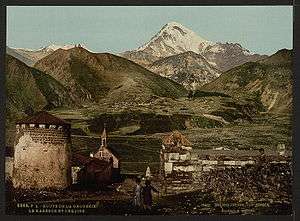 Construction of the Georgian Military Road through disputed territories was a key factor in the eventual Russian success
Construction of the Georgian Military Road through disputed territories was a key factor in the eventual Russian success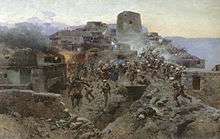 Assault of Gimry, by Franz Alekseyevich Roubaud
Assault of Gimry, by Franz Alekseyevich Roubaud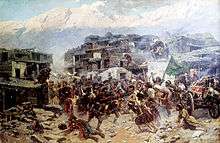 Caucasian tribesmen fight against the Cossacks, 1847
Caucasian tribesmen fight against the Cossacks, 1847 Storm of the fortress of Akhty in 1848
Storm of the fortress of Akhty in 1848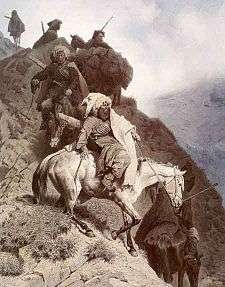 Circassians by Theodor Horschelt
Circassians by Theodor Horschelt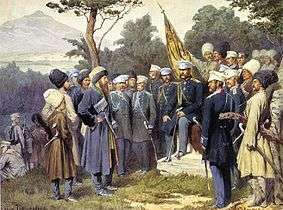 Imam Shamil surrendered to Count Baryatinsky on August 25, 1859
Imam Shamil surrendered to Count Baryatinsky on August 25, 1859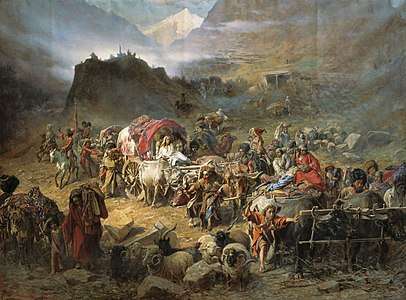 Mountaineers leave the aul, by Pyotr Gruzinsky
Mountaineers leave the aul, by Pyotr Gruzinsky- Russian medal for subjugation of Western Caucasus 1859–1864
References
- ↑ King, Charles (2008). The Ghost of Freedom: A History of the Caucasus. New York City, NY: Oxford University Press. ISBN 978-0-19-517775-6.
- ↑ Kemper, Michael (2010). Companjen, Françoise, ed. Exploring the Caucasus in the 21st Century: Essays on Culture, History and Politics in a Dynamic Context. Amsterdam: Amsterdam University Press.
- ↑ Dowling, Timothy C., ed. (2014). Russia at War. Santa Barbara, California: ABC-CLIO. pp. 728–730.
In 1801, Russia annexed the Georgian Kingdom of Kartli–Kakheti.
- ↑ Robert F Baumann and Combat Studies Institute (U.S.), Russian-Soviet Unconventional Wars in the Caucasus, Central Asia, and Afghanistan (Fort Leavenworth, Kan: Combat Studies Institute, U.S. Army Command and General Staff College, n.d.)
- ↑ Yale University paper Archived December 29, 2009, at the Wayback Machine.
- ↑ Bertolt Brecht The Caucasian Chalk Circle study guide http://www.gradesaver.com/the-caucasian-chalk-circle/study-guide/
Further reading
- Journal of a residence in Circassia during the years 1837, 1838, and 1839 - Bell, James Stanislaus (English)
- Dubrovin, N. Russian: (Дубровин Н.Ф.) История войны и владычества русских на Кавказе, volumes 4–6. SPb, 1886–88.
- Kaziev, Shapi. Imam Shamil. "Molodaya Gvardiya" publishers. Moscow, 2001, 2003, 2006, 2010
- Kaziev, Shapi. Akhoulgo. Caucasian War of 19th century. The historical novel. "Epoch", Publishing house. Makhachkala, 2008. ISBN 978-5-98390-047-9